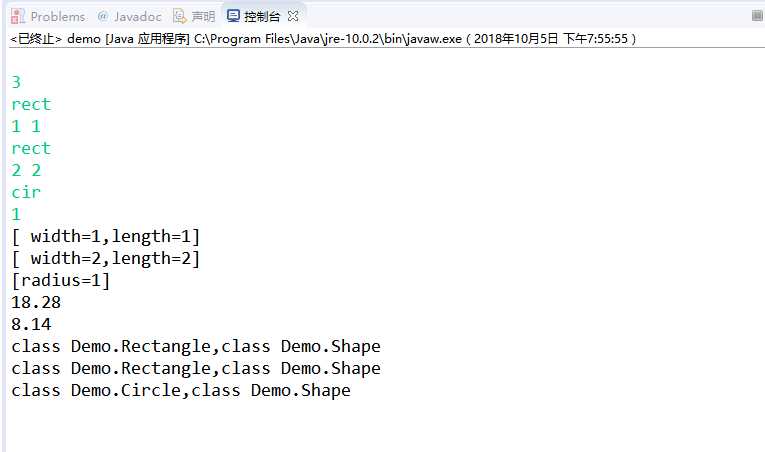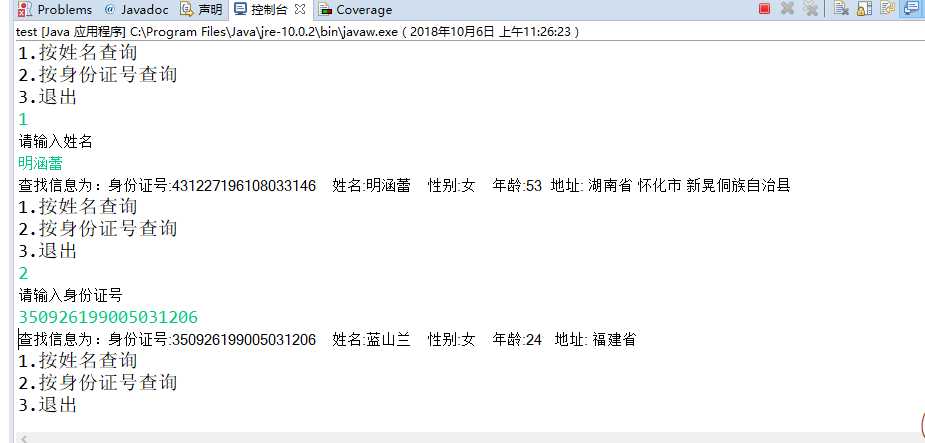201771010113 李婷华 《面向对象程序设计(Java)》第六周总结
2021-05-16 06:30
标签:size super def struct 指示 注释 maria local sci 一.理论知识部分 第四章 类与对象 1.方法的定义:方法声明和方法体。 2.重载:一个类中可以有多个方法具有相同的名字,不同的类型,不同的参数。 3.构造器:也叫构造方法,是类中的一种特殊的方法,其作用是用来构造并初始化对象。 4.构造器的名字必须与它所在的类名相同。每个类可以有一个以上的构造器。构造器可以有0个、1个或1个以上的参数。构造器没有返回值。构造器总是被new运算符调用。构造器可以调用另一个构造器。 5.类的访问权限:一个方法可以访问所属类的私有数据。 6.静态域:用static修饰的域为静态域,也叫类域,否则为实例域。 7.静态方法:用static修饰的方法为静态方法或类方法,静态方法可通过类名或对象来调用。静态方法不能操作对象,所有不能在静态方法中访问实例域,但静态方法可以访问自身类中的静态域。 8.建议使用类名来调用静态方法。 9.使用静态方法的情况:(1)一个方法不需要访问对象状态(2)一个方法只需访问类的静态域。 10.main方法是一个静态方法,启动程序时,静态main方法将执行并创建程序所需的对象。每一个类可以有一个main方法。 11.程序设计语言中将参数传递给方法的方式:(1)值调用(2)引用调用 12.一个方法可以修改传递引用所对应的变量值,而不能修改传递值调用所对应的变量值。 13.Java值调用:方法得到的是所有参数值的一个拷贝,方法不能修改传递给它的任何参数变量的内容。 14.Java中方法参数有两种类型:基本数据类型、对象。 15.一个方法不可能修改一个基本数据类型的参数。 16.Java中方法的对象参数采用的是值传递。 17.Java方法参数的使用:一个方法不能修改一个基本数据类型的参数。一个方法可以改变一个对象参数的状态。一个不能实现让对象参数引用一个新的对象。 18.对象的定义:对象的声明、创建对象。 19.类定义的变量中含有静态变量时,该类所有对象的静态变量共享同一存贮单元。 20.在类定义中,可以直接将一个常数赋给一个域。可调用方法对域进行初始化。 21.为实例域初始化的方法:(1)在构造器中设置值(2)声明的同时赋值(3)用初始化块 22.Java中常把多个类放在一起形成一个包。使用包的主要原因是确保类名的唯一性。 23.一个类可以直接使用它所在的包中的所有类,也可所有来自其他包中的所有public类。 24.访问其他包中的类的方式(1)类名前加上完整的包名(2)利用import语句导入特定的类。 25.import语句不仅可以导入类,还可以导入静态方法和静态域。 26.类中标记为public的部分可以被任意类使用。 27.类中标记为private的部分只能在类中使用。 第五章 继承 1.继承:用已有类来构造新类的一种机制。当定义了一个新类继承了一个类时,这个新类就继承了这个类的方法和域。 2.继承的特点:具有层次结构、子类继承了父类的方法和域。 3.继承的优点:(1)代码可重用性(2)可以轻松定义子类(3)父类的域和方法可用于子类(4)设计应用程序变得更加简单 4.子类比超类拥有的功能更加丰富。 5.通过扩展超类来定义子类时,仅需要指出子类与超类的不同之处。 6.super是一个指示编译器调用超类方法的特有关键字。 7.super的用途:(1)调用超类的方法(2)调用超类的构造器 8.超类中的方法可在子类中进行方法重写。 9.可将子类对象赋给超类变量。 10.方法的名称和参数列表称为方法的签名。 11.不允许继承的类称为final类,在类的定义中用final修饰符加以说明。 12.把超类对象赋给子类对象变量,就必须进行强制类型转换。 子类 对象=(子类)(超类对象变量) 13.为了提高程序的清晰度,包含一个或多个抽象方法的类本身必须被声明为抽象类。除了抽象方法之外,抽象类还可以包含具体数据和具体方法。 14.抽象方法充当着占位的角色,他们的具体实现在子类中。 15.抽象类不能被实例化,即不能创建对象,只能产生子类。可以创建抽象类的对象变量。 二.实验部分 1、实验目的与要求 (1) 理解继承的定义; (2) 掌握子类的定义要求 (3) 掌握多态性的概念及用法; (4) 掌握抽象类的定义及用途; (5) 掌握类中4个成员访问权限修饰符的用途; (6) 掌握抽象类的定义方法及用途; (7)掌握Object类的用途及常用API; (8) 掌握ArrayList类的定义方法及用法; (9) 掌握枚举类定义方法及用途。 2、实验内容和步骤 实验1: 导入第5章示例程序,测试并进行代码注释。 测试程序1: 在elipse IDE中编辑、调试、运行程序5-1 (教材152页-153页) ; 掌握子类的定义及用法; 结合程序运行结果,理解并总结OO风格程序构造特点,理解Employee和Manager类的关系子类的用途,并在代码中添加注释。 代码: 实验结果: OO风格程序构造特点:继承的特点是具有层次结构,使程序的构造思路看上去一目了然。 测试程序2: 编辑、编译、调试运行教材PersonTest程序(教材163页-165页); 掌握超类的定义及其使用要求; 掌握利用超类扩展子类的要求; 在程序中相关代码处添加新知识的注释。 代码: 实验结果: 测试程序3: 编辑、编译、调试运行教材程序5-8、5-9、5-10,结合程序运行结果理解程序(教材174页-177页); 掌握Object类的定义及用法; 在程序中相关代码处添加新知识的注释。 代码: 实验结果: 测试程序4: 在elipse IDE中调试运行程序5-11(教材182页),结合程序运行结果理解程序; 掌握ArrayList类的定义及用法; 在程序中相关代码处添加新知识的注释。 代码: 实验结果: 测试程序5: 编辑、编译、调试运行程序5-12(教材189页),结合运行结果理解程序; 掌握枚举类的定义及用法; 在程序中相关代码处添加新知识的注释。 代码: 实验结果: 实验2:编程练习1 定义抽象类Shape: 属性:不可变常量double PI,值为3.14; 方法:public double getPerimeter();public double getArea())。 让Rectangle与Circle继承自Shape类。 编写double sumAllArea方法输出形状数组中的面积和和double sumAllPerimeter方法输出形状数组中的周长和。 main方法中 1)输入整型值n,然后建立n个不同的形状。如果输入rect,则再输入长和宽。如果输入cir,则再输入半径。 思考sumAllArea和sumAllPerimeter方法放在哪个类中更合适? 输入样例: 3 rect 1 1 rect 2 2 cir 1 输出样例: 18.28 8.14 [Rectangle [width=1, length=1], Rectangle [width=2, length=2], Circle [radius=1]] class Rectangle,class Shape class Rectangle,class Shape class Circle,class Shape 代码: 实验结果: 实验3: 编程练习2 编制一个程序,将身份证号.txt 中的信息读入到内存中,输入一个身份证号或姓名,查询显示查询对象的姓名、身份证号、年龄、性别和出生地。 代码: 实验结果: 3.总结: 通过本章的学习,我理解了父类和子类的定义,而继承指的是子类继承父类的方法和域,以便于简化程序,在这个过程中常会用到关键字super。我也学会了如何去定义一个抽象类。但是在写程序的过程中,仍然有问题存在,虽然写出了实验二的程序,可是输出的格式和题目所要求的还是有出入,目前为止,这个问题依然没有想到解决的办法。通过这几周的学习,我的编程能力较以前还是有很大的长进,学会了许多以前不知道的知识,学会了什么情况下用for,while,do-while循环。 201771010113 李婷华 《面向对象程序设计(Java)》第六周总结 标签:size super def struct 指示 注释 maria local sci 原文地址:https://www.cnblogs.com/litinghua/p/9725244.htmlpackage inheritance;
/**
* This program demonstrates inheritance.
* @version 1.21 2004-02-21
* @author Cay Horstmann
*/
public class ManagerTest
{
public static void main(String[] args)
{
// 创建 Manager类
Manager boss = new Manager("Carl Cracker", 80000, 1987, 12, 15);
boss.setBonus(5000);//调用更改器
Employee[] staff = new Employee[3];
// fill the staff array with Manager and Employee objects
staff[0] = boss;//父类对象可引用子类对象
staff[1] = new Employee("Harry Hacker", 50000, 1989, 10, 1);
staff[2] = new Employee("Tommy Tester", 40000, 1990, 3, 15);
// 打印所有员工类的基本信息
for (Employee e : staff)
System.out.println("name=" + e.getName() + ",salary=" + e.getSalary());
}
}
package inheritance;
import java.time.*;
public class Employee
{
private String name;
private double salary;
private LocalDate hireDay;
public Employee(String name, double salary, int year, int month, int day)
{
this.name = name;
this.salary = salary;
hireDay = LocalDate.of(year, month, day);
}
public String getName()
{
return name;
}
public double getSalary()//访问器
{
return salary;
}
public LocalDate getHireDay()
{
return hireDay;
}
public void raiseSalary(double byPercent)
{
double raise = salary * byPercent / 100;//涨工资的专有操作
salary += raise;
}
}
package inheritance;
public class Manager extends Employee
{
private double bonus;
/**
* @param name the employee‘s name
* @param salary the salary
* @param year the hire year
* @param month the hire month
* @param day the hire day
*/
public Manager(String name, double salary, int year, int month, int day)
{
super(name, salary, year, month, day);//调用父类的方法
bonus = 0;
}
public double getSalary()//访问器
{
double baseSalary = super.getSalary();//调用父类的方法
return baseSalary + bonus;
}
public void setBonus(double b)//更改器
{
bonus = b;
}
}

package abstractClasses;
/**
* This program demonstrates abstract classes.
* @version 1.01 2004-02-21
* @author Cay Horstmann
*/
public class PersonTest
{
public static void main(String[] args)
{
Person[] people = new Person[2];
// fill the people array with Student and Employee objects
//有共同的父类
people[0] = new Employee("Harry Hacker", 50000, 1989, 10, 1);
people[1] = new Student("Maria Morris", "computer science");
// print out names and descriptions of all Person objects
for (Person p : people)
System.out.println(p.getName() + ", " + p.getDescription());
}
}
package abstractClasses;
public abstract class Person
{
public abstract String getDescription();//抽象方法
private String name;
public Person(String name)
{ //生成构造器时为子类构造器提供服务
this.name = name;
}
public String getName()
{
return name;
}
}
package abstractClasses;
import java.time.*;
public class Employee extends Person
{
private double salary;
private LocalDate hireDay;
public Employee(String name, double salary, int year, int month, int day)
{
super(name);
this.salary = salary;
hireDay = LocalDate.of(year, month, day);
}
public double getSalary()
{
return salary;
}
public LocalDate getHireDay()
{
return hireDay;
}
public String getDescription()//重写
{
return String.format("an employee with a salary of $%.2f", salary);
}
public void raiseSalary(double byPercent)
{
double raise = salary * byPercent / 100;
salary += raise;
}
}
package abstractClasses;
public class Student extends Person//继承关系
{
private String major;
/**
* @param nama the student‘s name
* @param major the student‘s major
*/
public Student(String name, String major)//构造器
{
// pass n to superclass constructor
super(name);//继承父类
this.major = major;
}
public String getDescription()//抽象方法的实现
{
return "a student majoring in " + major;
}
}

package equals;
/**
* This program demonstrates the equals method.
* @version 1.12 2012-01-26
* @author Cay Horstmann
*/
public class EqualsTest
{
public static void main(String[] args)
{
Employee alice1 = new Employee("Alice Adams", 75000, 1987, 12, 15);
Employee alice2 = alice1;
Employee alice3 = new Employee("Alice Adams", 75000, 1987, 12, 15);
Employee bob = new Employee("Bob Brandson", 50000, 1989, 10, 1);
System.out.println("alice1 == alice2: " + (alice1 == alice2));
System.out.println("alice1 == alice3: " + (alice1 == alice3));
System.out.println("alice1.equals(alice3): " + alice1.equals(alice3));
System.out.println("alice1.equals(bob): " + alice1.equals(bob));
System.out.println("bob.toString(): " + bob);
Manager carl = new Manager("Carl Cracker", 80000, 1987, 12, 15);
Manager boss = new Manager("Carl Cracker", 80000, 1987, 12, 15);
boss.setBonus(5000);
System.out.println("boss.toString(): " + boss);
System.out.println("carl.equals(boss): " + carl.equals(boss));
System.out.println("alice1.hashCode(): " + alice1.hashCode());
System.out.println("alice3.hashCode(): " + alice3.hashCode());
System.out.println("bob.hashCode(): " + bob.hashCode());
System.out.println("carl.hashCode(): " + carl.hashCode());
}
}
package equals;
import java.time.*;
import java.util.Objects;
public class Employee
{
private String name;
private double salary;
private LocalDate hireDay;
public Employee(String name, double salary, int year, int month, int day)
{
this.name = name;
this.salary = salary;
hireDay = LocalDate.of(year, month, day);
}
public String getName()
{
return name;
}
public double getSalary()
{
return salary;
}
public LocalDate getHireDay()
{
return hireDay;
}
public void raiseSalary(double byPercent)
{
double raise = salary * byPercent / 100;
salary += raise;
}
public boolean equals(Object otherObject)
{
// 快速检查对象是否相同
if (this == otherObject) return true;
// 判断两个引用是否是同一个
if (otherObject == null) return false;
// 是同一个,则这两个对象相等
if (getClass() != otherObject.getClass()) return false;
// 另一个对象是非空雇员
Employee other = (Employee) otherObject;
// 测试是否具有相同的值
return Objects.equals(name, other.name) && salary == other.salary && Objects.equals(hireDay, other.hireDay);
}
public int hashCode()
{
return Objects.hash(name, salary, hireDay);
}
public String toString()
{
return getClass().getName() + "[name=" + name + ",salary=" + salary + ",hireDay=" + hireDay
+ "]";
}
}
package equals;
public class Manager extends Employee
{
private double bonus;
public Manager(String name, double salary, int year, int month, int day)
{
super(name, salary, year, month, day);//继承父类
bonus = 0;
}
public double getSalary()
{
double baseSalary = super.getSalary();//调用父类的方法
return baseSalary + bonus;
}
public void setBonus(double bonus)
{
this.bonus = bonus;
}
public boolean equals(Object otherObject)
{
if (!super.equals(otherObject)) return false;
Manager other = (Manager) otherObject;
// 检查是否和其他的是同一个类
return bonus == other.bonus;
}
public int hashCode()//继承父类的方法
{
return java.util.Objects.hash(super.hashCode(), bonus);
}
public String toString()
{
return super.toString() + "[bonus=" + bonus + "]";
}
}

package arrayList;
import java.util.*;
/**
* This program demonstrates the ArrayList class.
* @version 1.11 2012-01-26
* @author Cay Horstmann
*/
public class ArrayListTest
{
public static void main(String[] args)
{
// 用三个雇员对象填充员工数组
ArrayList
package arrayList;
import java.time.*;
public class Employee
{
private String name;
private double salary;
private LocalDate hireDay;
public Employee(String name, double salary, int year, int month, int day)
{
this.name = name;
this.salary = salary;
hireDay = LocalDate.of(year, month, day);
}
public String getName()
{
return name;
}
public double getSalary()
{
return salary;
}
public LocalDate getHireDay()
{
return hireDay;
}
public void raiseSalary(double byPercent)
{
double raise = salary * byPercent / 100;
salary += raise;
}
}

package enums;
import java.util.*;
/**
* This program demonstrates enumerated types.
* @version 1.0 2004-05-24
* @author Cay Horstmann
*/
public class EnumTest
{
public static void main(String[] args)
{
Scanner in = new Scanner(System.in);
System.out.print("Enter a size: (SMALL, MEDIUM, LARGE, EXTRA_LARGE) ");
String input = in.next().toUpperCase();
Size size = Enum.valueOf(Size.class, input);
System.out.println("size=" + size);
System.out.println("abbreviation=" + size.getAbbreviation());
if (size == Size.EXTRA_LARGE)//比较两个枚举类型的值
System.out.println("Good job--you paid attention to the _.");
}
}
enum Size//声明枚举类
{
SMALL("S"), MEDIUM("M"), LARGE("L"), EXTRA_LARGE("XL");
private Size(String abbreviation) { this.abbreviation = abbreviation; }
public String getAbbreviation() { return abbreviation; }
private String abbreviation;
}

2) 然后输出所有的形状的周长之和,面积之和。并将所有的形状信息以样例的格式输出。
3) 最后输出每个形状的类型与父类型,使用类似shape.getClass()(获得类型),shape.getClass().getSuperclass()(获得父类型);package Demo;
import Demo.Shape;
import Demo.Rectangle;
import Demo.Circle;
import java.math.*;
import java.util.Scanner;
public class demo {
public static void main(String[] args) {
Scanner in=new Scanner(System.in);
System.out.println();
int n=in.nextInt();
String rect="rect";
String cir="cir";
Shape [] a=new Shape[n];
for(int i=0;i
package Demo;
public abstract class Shape {
double PI=3.14;
public abstract double getPerimeter();
public abstract double getArea();
}
package Demo;
public class Rectangle extends Shape{
private int width;
private int length;
public Rectangle(int wid,int len)
{
this.width=wid;
this.length=len;
}
public double getPerimeter()
{
return (width+length)*2;
}
public double getArea()
{
return width*length;
}
public double getWidth()
{
return width;
}
public double getLength()
{
return length;
}
public String toString()
{
return "Rectangle"+ "[ width=" + width + ","+ "length=" + length + "]";
}
}
package Demo;
public class Circle extends Shape{
private int radius;
public Circle(int r)
{
radius=r;
}
public double getPerimeter()
{
return 2*PI*radius;
}
public double getArea()
{
return PI*radius*radius;
}
public double getRadius()
{
return radius;
}
public String toString()
{
return "Circle"+"["+"radius=" + radius + "]";
}
}

import java.io.BufferedReader;
import java.io.File;
import java.io.FileInputStream;
import java.io.FileNotFoundException;
import java.io.IOException;
import java.io.InputStreamReader;
import java.util.ArrayList;
import java.util.Scanner;
public class Test{
private static ArrayList
public class Citizen {
private String name;
private String id ;
private String sex ;
private String age;
private String address;
public String getName() {
return name;
}
public void setName(String name) {
this.name = name;
}
public String getId() {
return id;
}
public void setId(String id) {
this.id = id;
}
public String getSex() {
return sex ;
}
public void setSex(String sex ) {
this.sex =sex ;
}
public String getAge() {
return age;
}
public void setAge(String age ) {
this.age=age ;
}
public String getAddress() {
return address;
}
public void setAddress(String address) {
this.address=address ;
}
}

文章标题:201771010113 李婷华 《面向对象程序设计(Java)》第六周总结
文章链接:http://soscw.com/essay/86142.html